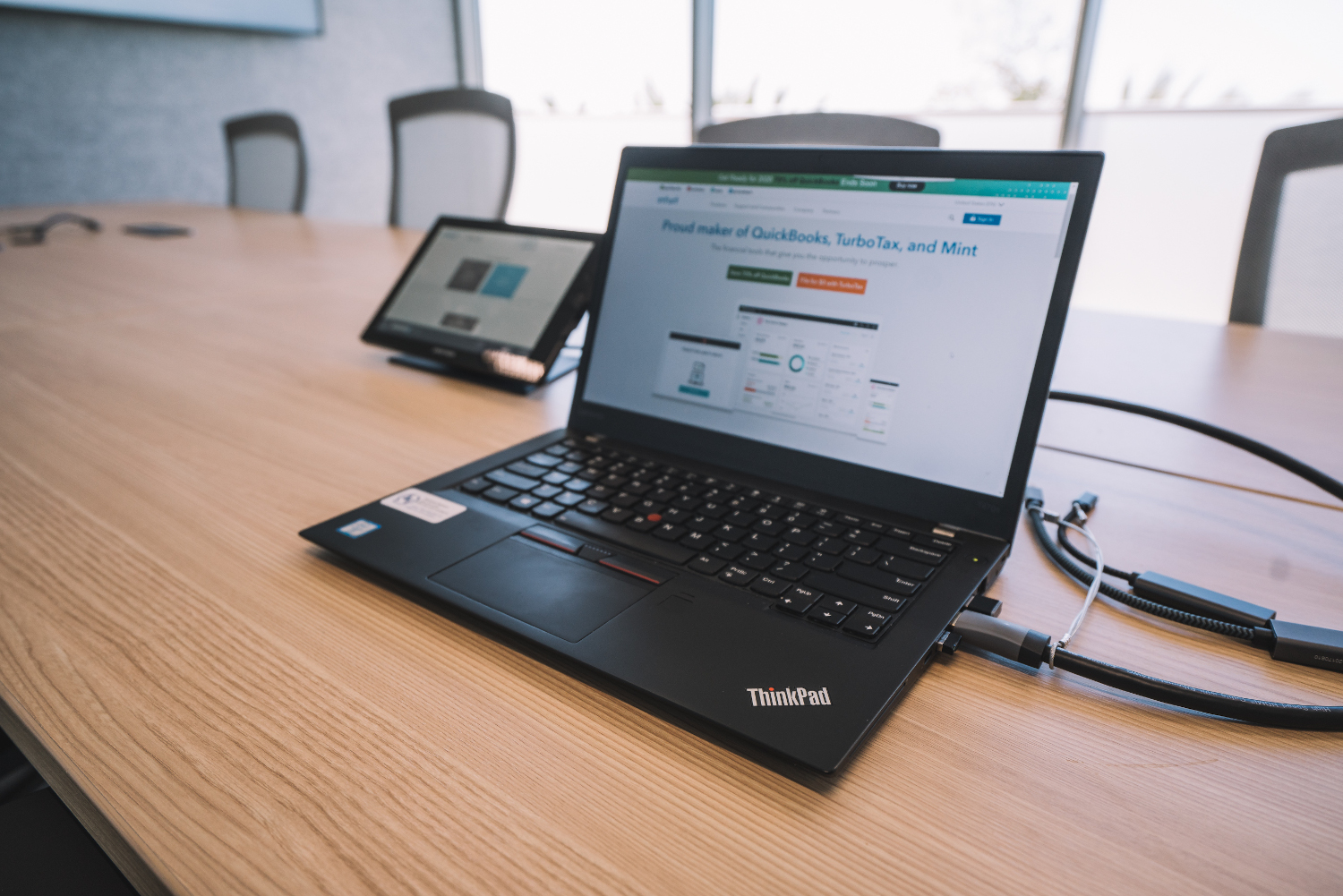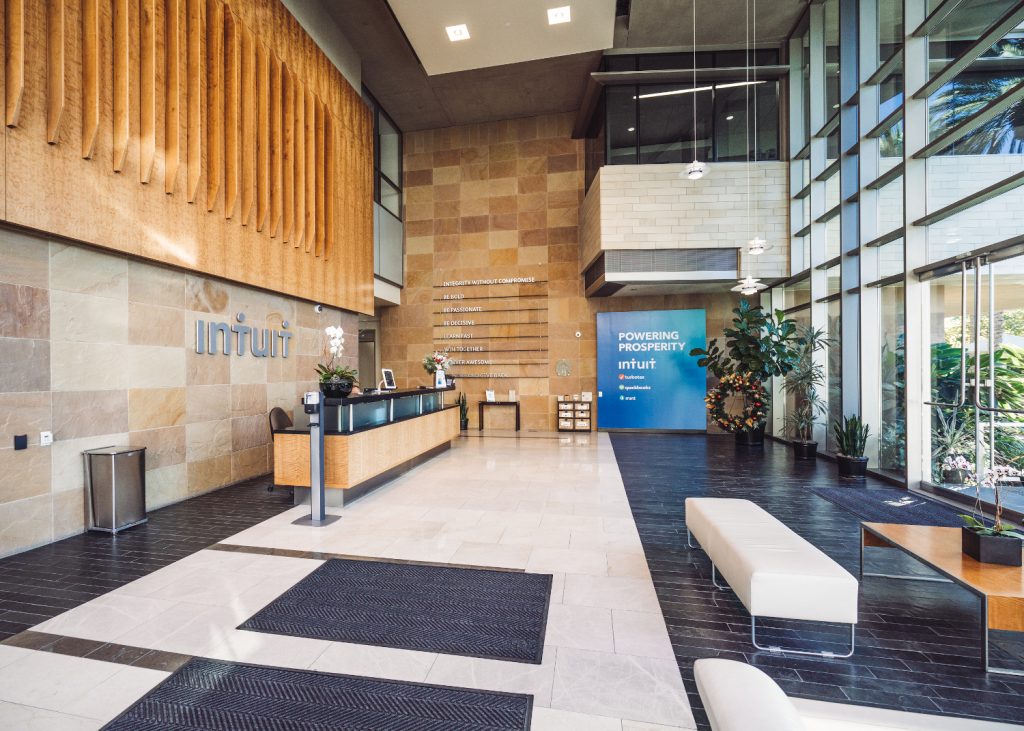In scientific research and landmark movements of social change, simple acts of collaboration are major factors that contribute to monumental breakthroughs and successes. Well, much the same is true for today’s fast-paced businesses. Like so many great ideas, opportunities to connect in the most basic of human ways can be so obvious as to hide in plain sight. When personal engagement does happen, relationships develop, ideas flow and progress is made. At its core, this is what applying AV technology to corporate campuses has always been intended to facilitate. Now, AV collaboration in the cloud offers us unprecedented reliability, as well as the requisite quality to make powerful personal connections with colleagues in the next city and around the globe.
The steady evolution of audio conferencing over past decades, as well as the recent introduction of robust messaging applications into even technologically rudimentary business settings, offers incontrovertible proof that our industry can help spark collaboration when parties aren’t conveniently co-located. “In our experience, offering meeting participants a video connection is simply the best way to help them collaborate,” Fletcher Buñales, Manager of Unifi ed Communications at Intuit, said. He continued, “When you can see whom you’re talking to, it’s like you’re in the same room. Video bridges the gap, and things happen.”
Forward-looking companies like Intuit, the maker of QuickBooks, TurboTax and Mint, continue to be committed to improving the videoconferencing experience. And, with today’s confluence of video-compression standards, proven voice-over-IP (VoIP) protocols, cloud connectivity and product innovations, videoconferencing is closer than ever to connecting desktops, mobile devices and room systems in one unified video meeting. However, to reap the benefits that this powerful collaborative catalyst offers, companies must commit themselves to implementing videoconferencing systems that are at once available, reliable and easy to use.
Videoconferencing Teamwork
With a global workforce of more than 9,000 employees—a number that increases during various peaks throughout the year due to the seasonality of parts of its business—Intuit prioritizes bringing workers, leaders and business partners closer together. Buñales revealed, “We currently support videoconferencing across 19 global locations, including Australia, Brazil, Canada, Mexico, the United Kingdom, France, India and Israel.”
Buñales is supported by a team of eight engineers at Intuit offices in California and Texas. He works closely with the company’s IT department, hardware and software vendors, and videoconferencing users to establish best-in-class standards for a robust, scalable infrastructure to support the demands of real-time, high-quality videoconferencing and for the equipment that is integrated into the various environments.
Buñales is available for specific expertise, when necessary, because, to be successful, the systems that his team certifies must not only meet or exceed technical expectations, but also provide the kind of positive user experience that’s required to promote genuine human connection. When participating in a videoconference, if the image, sound or overall quality is impaired, if the environment is uncomfortable or if a system isn’t readily operable by its users, the value is diminished greatly. Videoconferences that don’t inspire a human connection between the participants ultimately fail at their mission.
To ensure quality videoconferencing experiences at Intuit, Peter Kolak, Videoconferencing Services Manager, leads an operations staff of nine experienced engineers and nine contractors who tend to day-to-day videoconferencing operations at the company’s locations. Kolak’s team handles support functions—everything from helping a single user in a single huddle room, to addressing the special needs presented by a training room, to facilitating high-profi le “white-glove” events. Kolak plays a critical role in helping Buñales in the certification process for new gear and services, as well as in building and commissioning new conference spaces.
The two teams’ coordinated efforts guarantee that the equipment installed will be right for each space, will be in line with Intuit’s scalable architecture and will be remotely supportable by Kolak’s team. According to Kolak, “Our goal for Intuit’s videoconferencing is, of course, to be best in class in terms of quality, but also to deliver technology that is service agnostic. People shouldn’t have to care what service they are connecting to, whether it’s WebEx, Teams, BlueJeans, Zoom or others. It’s the capabilities of collaboration tools, and whether they are user-friendly, that matter most.”
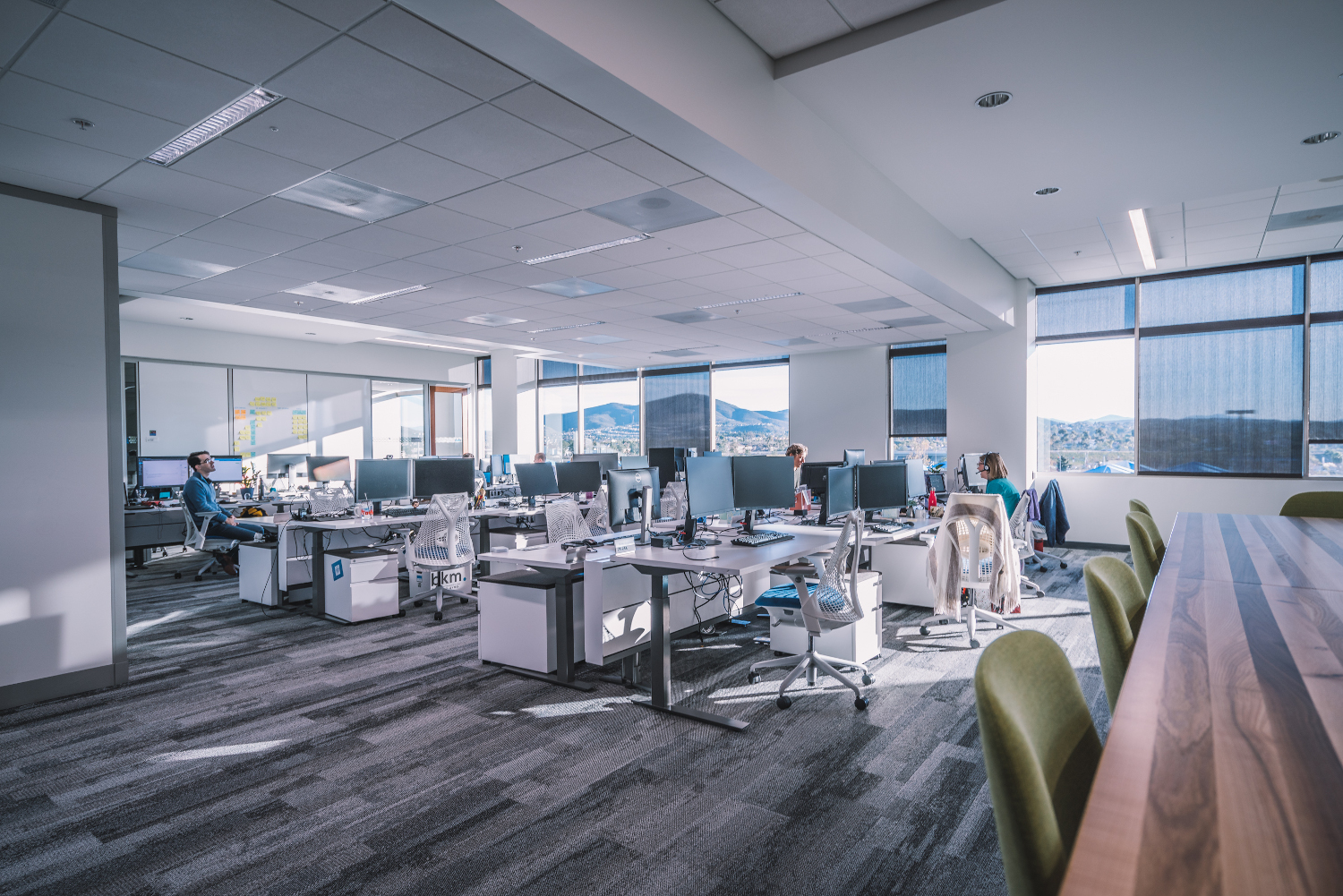
Building An Infrastructure
The foundation of Intuit’s successful videoconferencing platform is Intuit’s strategic shift from hosting applications at its own data centers to utilizing web-based or cloud offerings. Intuit has transitioned many of its applications from on-premise solutions to the cloud, and it has changed its wide area network (WAN) design. The company migrated from a traditional centralized data center model to a decentralized approach that involves dual direct internet access (DIA) circuits at each Intuit location. This shortened the path from Intuit’s offices to the internet, and it allowed the company to migrate from costly multiprotocol label switching (MPLS) circuits and dependence on data-center infrastructure. Buñales shared, “Committing to an infrastructure that connects each of our offices securely to the internet allows us to leverage cloud-based communication services and connectors that provide the flexibility we need, [along with] benefits like redundancy, scalability and maintenance that are handled by the provider.”
In 2015, Intuit was searching for a new video-bridging solution that would best fi t the company’s videoconferencing needs. The requirements included being cloud-based and standards-based to support the large number of video room systems installed at Intuit’s offices; moreover, it had to be accessible from computers and mobile devices. After considering multiple platforms, Intuit decided on BlueJeans for its room-centric conferencing style and its mix of equipment and collaboration tools. The deployment of BlueJeans to the enterprise enabled Intuit to sunset expensive, on-premise equipment, and it has made video collaboration more readily available to in-office employees, remote employees and partners.
At the same time, Intuit was searching for a new videoconferencing hardware vendor. After evaluating several options, Intuit selected Poly (then Polycom). Buñales and his team were looking for an infrastructure partner who was willing to listen and partner closely with customers. “We are particularly attuned to working with companies that are less rigid and [that] take the time to understand our needs,” Buñales shared. “The combination of Poly and the BlueJeans service offers us the reliable service and flexibility we need to adapt as conditions change.” Since the shift to Poly and BlueJeans, videoconferencing adoption has skyrocketed. Intuit currently averages more than 16 million minutes per month on its videoconferencing platform.

Room-Centric Design
Intuit’s commitment to deploy and support a room-centric design—not a PC-centric one—heavily influences its videoconferencing user experience. The forward-looking decision both facilitates Intuit company operations and makes support easier, while also creating a videoconferencing experience that is more reliable and natural.
Buñales and his team certify the room designs and equipment that Kolak’s operations team will ultimately deploy and support. “It’s a ‘cookie-cutter’ approach,” Buñales said, “[and it’s] simple and effective.” Adapting from a standard bill of materials makes the design process for new locations more efficient, but it also presents opportunities to streamline deployments and support. As an example, Buñales pointed to the ability to preprogram Crestron control software so that, when the software is loaded onto a tablet at the new location, it will ask for the number of microphones or displays there and configure equipment accordingly.
The room-based approach also presents opportunities to optimize design when products are particularly well suited to the videoconferencing experience. Some simple examples are unobtrusive (but extremely effective) cable cubbies, such as Extron’s Cable Cubby 700 and AMX’s HPX-1200. These provide organized cable control for videoconferences that include mobile gear that requires power or connectivity. A more complex example, although an equally powerful one, centers on Poly’s new series of video bars.
“We are currently in the process of certifying Poly’s Studio X video bars,” Kolak explained. “Their inclusion in our designs would present a number of advantages for our installation process and our users’ experience.” These units combine a number of attractive features in one easy-to-install device. They offer multiple native operational modes for cloud service providers (with a growing list that includes Microsoft Teams and Zoom today), as well as an H.323/Session Initiation Protocol (SIP) mode. In addition, they offer a 4K electronic pan-tilt-zoom (ePTZ) camera with automatic framing and tracking; wireless content sharing; high-quality sound from an internal microphone array; advanced MeetingAI features that filter out noise and create TV-production-quality transitions; and single- or dual-monitor support (in the Studio X50.) The Studio X30 delivers a fully functional huddle room at a total cost lower than cobbling together a system with separate PCs, cameras, microphones and other do-it-yourself (DIY) peripherals would entail.
The benefits of a room-based design are not all so tangible, though. The awareness of the user experience that a room-based design highlights, along with the resulting decisions that are made, can directly affect how frequently rooms are used and how effective they are. As an example, although pan-tilt-zoom (PTZ) cameras’ ability to track movements in a room can be important to a meeting, early camera implementations that achieved this appeared to be tracking room occupants too overtly. This made some people feel uneasy. Because of that, Intuit’s room design has been altered in favor of cameras that are less conspicuous to conference participants.
Intuit’s videoconference-room configurations include two intimate huddle-room designs; typical small-to-medium videoconference rooms with single or dual displays; medium-to-large videoconference rooms with single or dual displays; training rooms that might or might not be divisible and that have several display and control-room options; and event rooms of various sizes that are larger and more elaborate.
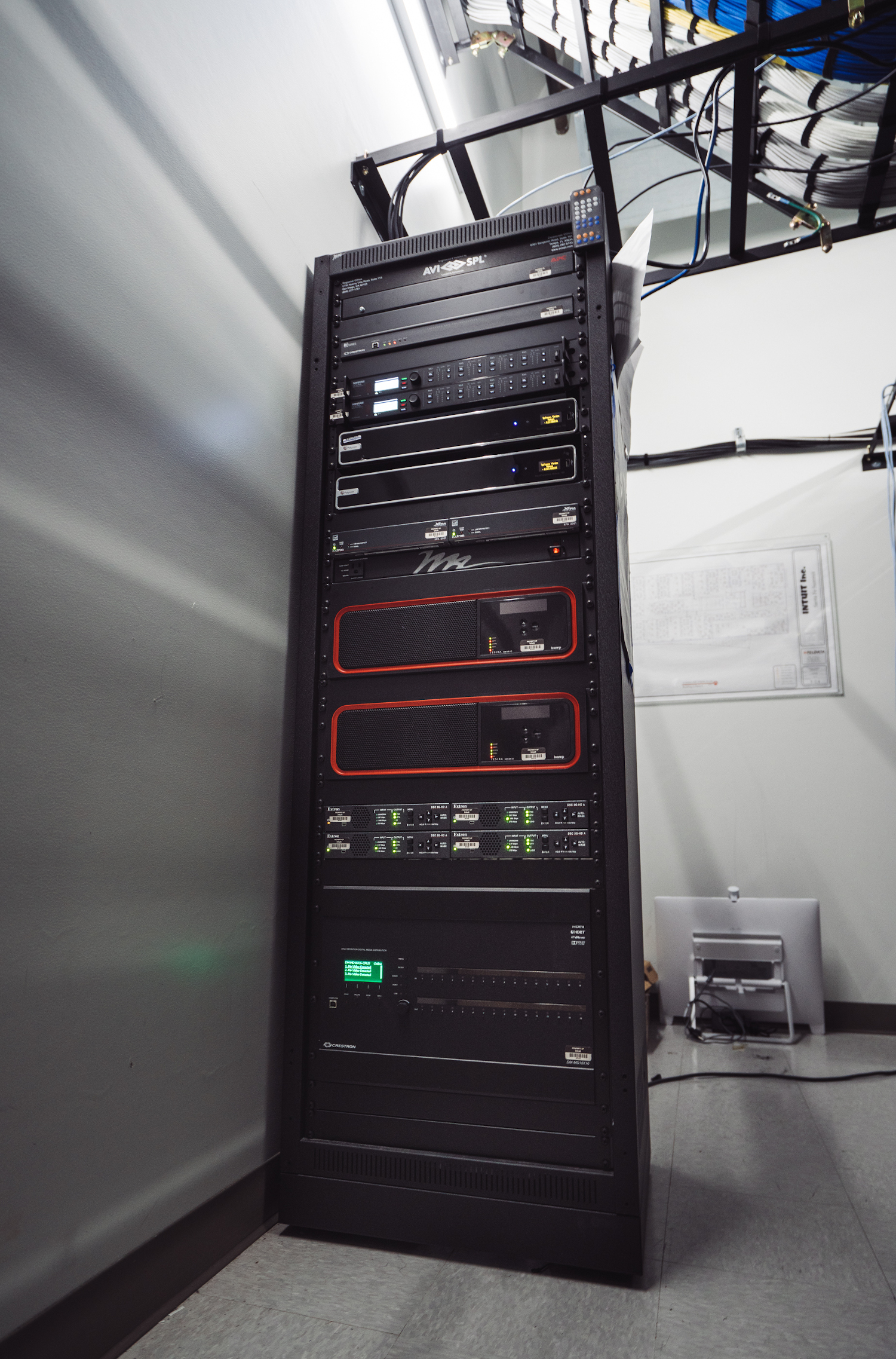
Huddle Rooms
Intuit’s huddle-room designs support two sizes: The smaller room design entails a front wall of six feet to 10 feet, with displays that are 10 feet from the farthest viewer. The larger rooms have displays that are up to 16 feet from the farthest viewer. The huddle rooms use Samsung QM55R 55-inch or QM65R 65-inch flat-panel displays mounted with Chief XTM1U wall-mount hardware. Video is handled with a Crestron DM-TX-4KZ-302-C 4K DigitalMedia 8G+ transmitter for the larger rooms, as well as a DM-RMC- 4K-100-C 4K DigitalMedia 8G+ receiver and room controller. Visual communications are handled by the room camera and a Poly RealPresence Group 310-720p HD codec and EagleEye Cube HDCI camera package. Clear audio is supplied by a Crestron UC videoconference smart soundbar, and the microphone is built into the EagleEye Cube. A Crestron DIN-AP3 3-Series automation processor handles control processing, aided by a Crestron tabletop 10-inch touchscreen. Upgrades to this huddle-room design could incorporate the Poly X30 videoconferencing bar, currently in certification.
Videoconference Rooms
Intuit’s videoconference-room designs support four approximate room sizes: front-wall width of seven feet to 11 feet, with 19 feet to the farthest viewer; 14-foot to 18-foot front walls, with 19 feet to the farthest viewer; eight-foot to 12-foot front walls, with 24 feet to the farthest viewer; and 15-foot to 19-foot front walls, with 24 feet to the farthest viewer. Whereas the smaller rooms use single or dual Samsung QM65R 65-inch or QM75R 75-inch flat-panel displays mounted with Chief XTM1U tilting landscape wall mounts, the larger rooms support the use of single or dual Samsung QM85N 85-inch flat-panel displays.
Video signals are handled with a Crestron DMTX-4KZ-302-C DigitalMedia 8G+ 4K60 4:4:4 HDR transmitter and a Crestron DM-RMC-4KZ-SCALER-C DigitalMedia receiver and room controller with scaler. Inputs are from an EagleEye Cube HDCI camera and a Poly HDX ceiling microphone and ceiling microphone array, or via the microphone built into the EagleEye Cube HDCI camera when the room is small enough. Use of Poly extenders can move camera devices as far as 330 feet, if necessary. Poly RealPresence Group 500-720p HD codecs are used in larger videoconference rooms. Audio is handled with a Crestron UC videoconference smart soundbar in smaller conference rooms; by contrast, larger rooms are supported by a QSC SPA2 200W mono amplifier driving JBL Control 26CT full-range, 6.5-inch, low-profile, 70/100V ceiling speakers. Upgrades to medium videoconference-room designs could use the Poly X50 videoconferencing bar, currently in certifi cation. A wall-mounted Crestron DIN-AP3 3-Series control processor with a tabletop Crestron TSW-1060-B-S 10-inch touchscreen panel provides automation control. Designed for convenient installation and enhanced scalability, the DIN-AP3 offers Intuit technicians a high-speed, modular programming architecture to run the standards-based program without issue. Changes can be made remotely via IP as part of a larger network. “It’s important that our room designs be supportable remotely,” Kolak stressed.
Training Rooms
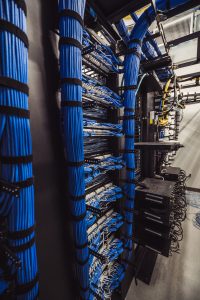
Training-room designs provide both for rooms without a control area and for rooms with a control area or cart. Display duties can handled by dual Samsung QM85N 85-inch or QM98N 98-inch flat-panel displays with Chief XTM1U mounts; alternatively, they can be handled by dual Christie GS Series DWU635-GS projectors trained on Da-Lite 113-inch-diagonal ceiling-recessed electric screens or dnp Supernova Blade 110-inch screens. In instances in which projectors are deployed, Chief RPAUW universal projector mounts with three-foot to five-foot adjustable extension columns hold the projectors securely in place.
For clean video in the training rooms, Intuit favors Crestron DM-TX-4KZ-302-C DigitalMedia 8G+ 4K60 4:4:4 HDR transmitters and Crestron DM-RMC-4KZ-SCALER-C DigitalMedia receivers and room controllers with scalers, along with DMC-4K-C HD input cards and DMC-4KZ-CO-HD and DMC-4KZ-HD output cards with a DM-MD8x8 DigitalMedia matrix switcher.
Videoconferencing inputs for training rooms include a Poly RealPresence Group 700 HD codec with EagleEye IV 12x conference camera(s) with camera extender(s). (Additional secondary camera and Panasonic AW-HN130-HD PTZ camera are optional.) Shure MXA910 ceiling array microphones, as well as Shure wireless bodypack, handheld and earset microphones, are used for presenters, along with Biamp Tesira audio mixing and processing with 64×64 Dante I/O abilities.
As in the larger videoconference rooms, audio is supported by a QSC SPA2 200W mono amplifier that drives JBL Control 26CT full-range, 6.5-inch, low-profile, 70/100V ceiling speakers and Control 19CS eight-inch subwoofers. A Crestron CP3 3-Series automation processor with TSW-1060-B-S 10-inch tabletop touchscreen provides control.
Event Spaces
Intuit’s event spaces can be two or three rooms that are divisible with tables and without a technician control area, with a lectern or table and in-room rack, or divisible and with a fully equipped control rooms, Samsung QM85N 85-inch or QM98N 98-inch flat-panel displays can be called upon to provide video support; the alternatives are Christie GS Series DWU635-GS projectors trained on Da-Lite 113-inch-diagonal ceiling-recessed electric screens or dnp Supernova Blade 110-inch screens, as called for. Event spaces add Samsung QM49R 49-inch and QM55R 55-inch flat-panel displays on Chief confidence carts as downstage monitors.
Larger numbers of Crestron DM-TX-4KZ-302-C 4K DigitalMedia 8G transmitters and Crestron DM-RMC-4KZ-SCALER-C DigitalMedia receivers and room controllers with scalers are deployed in the event spaces. Crestron DMC-4K-C HD input cards, along with DMC-4KZ-CO-HD and DMC-4KZ-HD output cards, support a Crestron DM-MD32X32-CPU3 32×32 DigitalMedia switcher.
Multiple Poly RealPresence Group 700-720p HD codecs with EagleEye IV 12x conference camera and microphone, as well as Panasonic AW-RP50 and AWHN130-HD PTZ cameras, provide video inputs for large event spaces. The designs also add an Attero Tech Synapse D16 MIO Dante-enabled, 16-channel networked audio interface to the standard large-room audio package. That includes Shure ceiling array, wireless bodypack, handheld and earset microphones used for presenters and audience members, along with Biamp Tesira audio mixing and processing. Audio is supported by QSC CX108V amplifiers, as needed, that drive JBL Control 26CT full-range, 6.5-inch, low-profi le, 70/100V ceiling speakers and Control 19CS eight-inch subwoofers.
Event spaces add a Crestron DME-DGE digital graphics engine with 4K and a 21.5-inch touchscreen for tech control to the large-room standard of a Crestron CP3 3-Series automation processor for room control with a TSW-1060-B-S 10-inch tabletop touchscreen.
TEEM room-scheduling software with a Crestron TSS-10 10.1-inch room-scheduling touchscreen with surface-mount kit help handle room demand. Samsung QM55R 55-inch flat-panel displays and Chief TS525TU mounts are deployed in lobby and break areas.
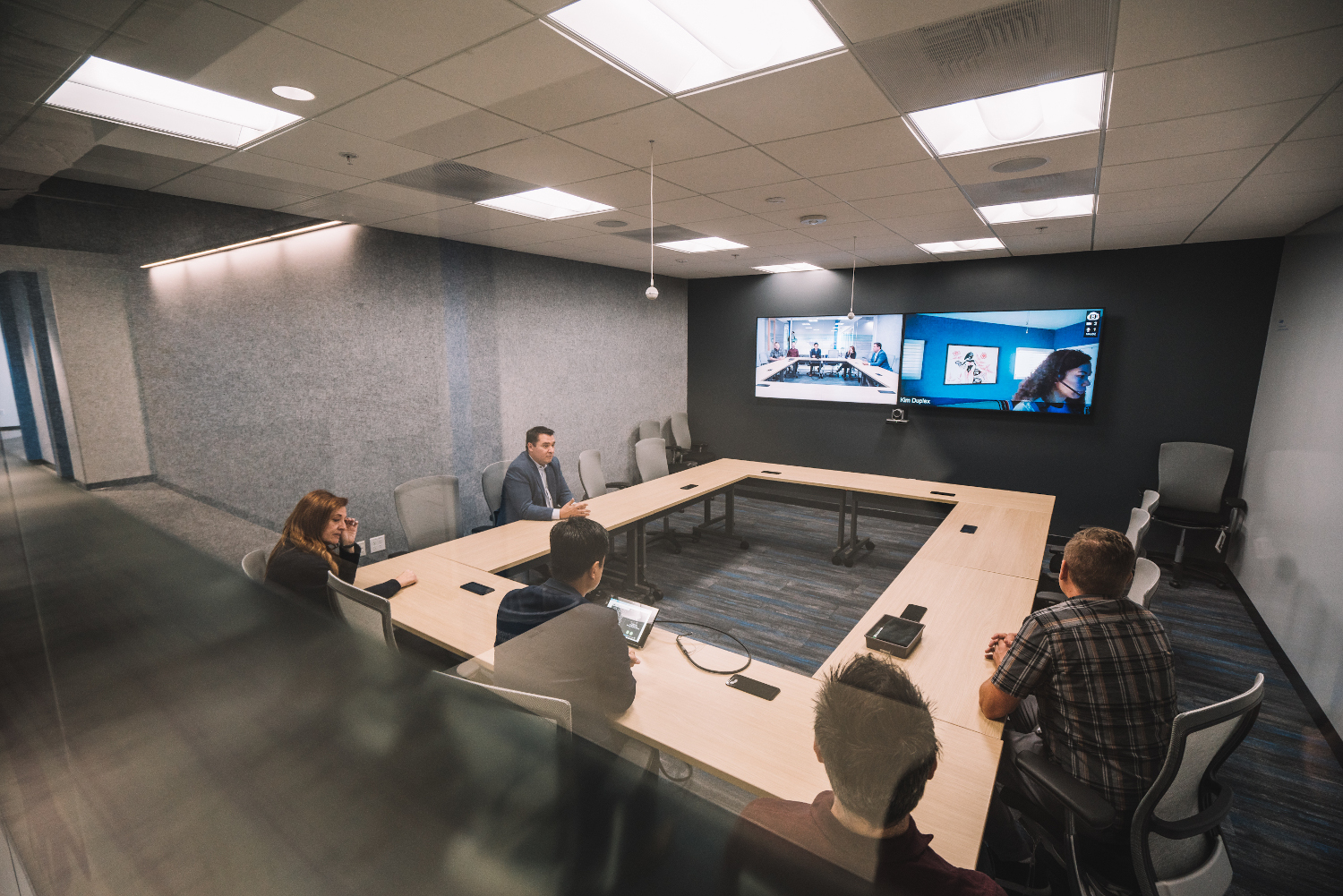
Wisdom In Standard Room Configurations
Developing and maintaining standard room configurations for videoconferencing spaces expedites troubleshooting, equipment repair and deployment of new facilities. And, if that were all the approach did, it would be enough. Its real power, however, lies in how it helps Kolak’s team of support engineers guarantee an optimal experience for all users—a group that encompasses Intuit employees, key business allies, corporate customers, business partners and many others across multiple geographies. To keep pace with innovation and react quickly to changes in any market, businesses must have more and better systems that promote good communication.
Although Buñales and Kolak build Intuit’s videoconference rooms to standards, Kolak was quick to add that Intuit’s rooms are not tied to a specifi c videoconferencing experience. “It’s not about who has the latest and greatest gear,” he declared, “and we don’t build our rooms for Zoom, Teams or any other specific room experience.” Rather, Intuit’s goal is to build videoconferencing spaces that make it easy and natural to get to the service “above.” Kolak concluded, “Users shouldn’t have to care what kind of meeting it is or [what] the service [is]. What they want is to get out of the room and into their meeting.”

EQUIPMENT
HUDDLE ROOMS
Display
1 Chief XTM1U tilting landscape wall mount
1 Samsung QM55R/QM65R 55″/65″ flat-panel display Video
1 Crestron CBL-HD-LOCK-4 locking high-speed HDMI cable, 10.2Gb/s (4′)
1 Crestron DM-RMC-4K-100-C 4K DigitalMedia 8G+ receiver and room controller
1 Crestron DM-TX-4KZ-302-C DigitalMedia 8G+ 4K60 4:4:4 HDR transmitter
1 Poly EagleEye Cube conference camera
1 Poly RealPresence Group 310-720p videoconferencing kit w/EagleEye Audio
1 Crestron UC-SB1 UC videoconference smart soundbar Control
1 Crestron DIN-AP3 DIN rail 3-Series automation processor
1 Crestron TSW-1060-B-S 10.1″ touchscreen (black, smooth)
1 Crestron TSW-1060-TTK-B-S tabletop kit for TSW-1060-B-S
VIDEOCONFERENCE ROOMS
Display
2 Chief XTM1U tilting landscape wall mounts
2 Samsung QM65R/QM75R 65″/75″ flat-panel displays
Video
1 Crestron DM-RMC-4KZ-SCALER-C DigitalMedia 8G+ 4K60 4:4:4 HDR receiver and room controller w/scaler
1 Crestron DM-TX-4KZ-302-C DigitalMedia 8G+ 4K60 4:4:4 HDR transmitter
1 Poly ceiling-mic extension kit
1 Poly EagleEye Cube conference camera
1 Poly HDX ceiling mic
1 Poly RealPresence 500 videoconferencing kit
1 Sound Control Technologies RemoteCam4-Producer-KS EagleEye IV camera extender
Audio
1 Crestron UC-SB1 UC videoconference smart soundbar Control
1 Crestron DIN-AP3 DIN rail 3-Series automation processor
1 Crestron TSW-1060-B-S 10.1″ touchscreen (black, smooth)
1 Crestron TSW-1060-TTK-B-S tabletop kit for TSW-1060-B-S
TRAINING ROOMS
Display
2 Chief CMS0305W 3′ to 5′ adjustable extension columns
2 Chief RPAUW universal projector mounts
2 Chief XTM1U 98″ tilt monitor mounts
2 Christie GS Series DWU635-GS DLP projectors
2 Da-Lite 34538LS 113″-diagonal ceiling-recessed electric screens (option 1)
2 dnp Supernova Blade 110″ frameless front-projection screens (option 2)
2 Samsung QM85N 85″ flat-panel displays (option 1, in lieu of projectors)
2 Samsung QM98N 98″ flat-panel displays (option 2, in lieu of projectors)
Video
4 Crestron DMC-4K-C HDBaseT-certified 4K DigitalMedia 8G+ input cards for DM switchers
3 Crestron DMC-4KZ-CO-HD 2-channel DigitalMedia 8G+ 4K60 4:4:4 HDR output cards for DM switchers
4 Crestron DMC-4KZ-HD HDMI 4K60 4:4:4 HDR input cards for DM switchers
5 Crestron DMC-4KZ-HDO 2-channel HDMI 4K60 4:4:4 HDR scaling output cards for DM switchers
1 Crestron DM-MD8x8 8×8 DigitalMedia switcher
3 Crestron DM-RMC-4KZ-SCALER-C DigitalMedia 8G+ 4K60 4:4:4 HDR receivers and room controllers w/scalers
2 Crestron DM-TX-4KZ-302-C DigitalMedia 8G+ 4K60 4:4:4 HDR transmitters
2 Panasonic AW-HN130-HD PTZ cameras w/NDI
1 Poly RealPresence Group 700 w/EagleEye IV 12x conference camera
Audio
1 Biamp Tesira DAN-1 digital audio networking card
8 Biamp Tesira SEC-4 4-channel mic/line modular input cards w/AEC
1 Biamp Tesira SERVER-IO digital network server
2 Biamp Tesira SOC-4 4-channel line-level modular output cards
2 JBL Control 19CS 8″ subs (42Hz to 200Hz, 8Ω)
12 JBL Control 26CT full-range ceiling speakers w/6.5″ low profiles
1 QSC SPA2-200 mono 70/100V amp (200W)
4 Shure MX153 earset headworn omnidirectional mics
2 Shure MXA910 ceiling array mics
2 Shure UA864US wall-mounted wideband antennas
4 Shure ULXD1 digital wireless bodypack transmitters
4 Shure ULXD2 digital handheld wireless transmitters
1 Shure ULXD4Q quad-channel digital wireless receiver
Control
1 Crestron CP3 3-Series control system
1 Crestron TSW-1060-B-S 10.1″ touchscreen (black, smooth)
1 Crestron TSW-1060-TTK-B-S tabletop kit for TSW-1060-B-S
EVENT SPACES
Display
6 Chief CMS0305W 3’ to 5’ adjustable extension columns
2 Chief MFQUB medium confidence-monitor carts (2’)
6 Chief RPAUW universal projector mounts
6 Chief TS525TU large THINSTALL dual swing arm wall display mounts
6 Chief XTM1U 98″ monitor mounts
6 Christie GS Series DWU635-GS DLP projectors
6 Da-Lite 113″-diagonal ceiling-recessed electric screens (option 1)
6 dnp SuperNova Blade 110″ frameless front-projection screens (option 2)
2 Samsung QM49R 49″ flat-panel displays (option 1)
2 Samsung QM55R 55″ flat-panel displays (option 2)
6 Samsung QM85N 85″ flat-panel displays (option 1, in lieu of projectors)
6 Samsung QM98N 98″ flat-panel displays (option 2, in lieu of projectors)
Video
3 AJA HA5-4K HDMI-to-SDI converters
6 Crestron DMC-4K-C HDBaseT-certified 4K DigitalMedia 8G+ input cards for DM switchers
8 Crestron DMC-4KZ-CO-HD 2-channel DigitalMedia 8G+ 4K60 4:4:4 HDR output cards for DM switchers
14 Crestron DMC-4KZ-HD HDMI 4K60 4:4:4 HDR input cards for DM switchers
24 Crestron DMC-4KZ-HDO 2-channel HDMI 4K60 4:4:4 HDR scaling output cards for DM switchers
6 Crestron DMC-SDI 3G-SDI input cards for DM switchers
1 Crestron DM-MD32X32-CPU3 32×32 DigitalMedia switcher
8 Crestron DM-RMC-4KZ-SCALER-C DigitalMedia 8G+ 4K60 4:4:4 HDR receivers and room controllers w/scalers
6 Crestron DM-TX-4KZ-302-C DigitalMedia 8G+ 4K60 4:4:4 HDR transmitters
6 Extron DSC 3G-HD A 3G-SDI to HDMI scalers w/audio embedding
6 Panasonic AW-HN130-HD PTZ cameras w/NDI
1 Panasonic AW-RP50 PTZ camera controller
3 Poly RealPresence Group 700s w/EagleEye IV 12x conference cameras
Audio
1 Attero Tech Synapse D16 MIO Dante/AES67 networked audio interface (16-channel I/O)
3 Biamp Tesira DAN-1 digital audio networking cards
24 Biamp Tesira SEC-4 4-channel mic/line modular input cards w/AEC
3 Biamp Tesira SERVER-IO digital network servers
10 Biamp Tesira SOC-4 4-channel line-level modular output cards
6 JBL Control 19CS 8″ subs (42Hz to 200Hz, 8Ω)
18 JBL Control 26CT full-range ceiling speakers w/6.5″ low profiles
1 QSC CX108V 70V power amps
12 Shure MX153 earset headworn omnidirectional mics
6 Shure MXA910 ceiling array mics
3 Shure UA864US wall-mounted wideband antennas
12 Shure ULXD1 digital wireless bodypack transmitters
12 Shure ULXD2 digital handheld wireless transmitters
3 Shure ULXD4Q quad-channel digital wireless receivers
Control
1 Crestron CP3 3-Series control system
1 Crestron DM-DGE-100-C digital graphics engine w/ DM 8G+ input
2 Crestron TSD-2220-B 21.5″ HD touchscreen display (black)
3 Crestron TSW-1060-B-S 10.1″ touchscreens (black, smooth)
3 Crestron TSW-1060-TTK-B-S tabletop kits for TSW-1060-B-S
COMMON EQUIPMENT
Occupancy Sensor
1 Crestron GLS-ODT-C-CN dual-technology occupancy sensor w/Cresnet (2,000 square feet)
Racks and Accessories
1 APC AP7901B Ethernet-controlled power strip
1 APC AP7920 Ethernet-controlled power strip
2 APC PZ62B power strips w/6 outlets
1 AVF Rack-21 21U mobile rack
1 Middle Atlantic RLNK-1615 15A, 16-outlet, lower profile vertical, IP-controlled power w/RackLink
1 Middle Atlantic RLNK-415 15A, 4-outlet, compact, IP-controlled power w/RackLink Cable Cubby (AMX)
1 AMX HPX-1200-BL 1200 Series Hydra Port table box
1 AMX HPX-AV102-HDMI-R single HDMI module w/retractable cable
1 AMX HPX-AV102A-MDP-R mini DP module w/retractable cable
1 AMX HPX-N102-ETH-R Ethernet module w/retractable cable
1 AMX HPX-N102-USB-PC dual USB power module
1 AMX HPX-P200-PC-EU AC power outlet Cable Cubby (Extron)
2 Extron Cable Cubby 700 cable access enclosures (black; AC modules not included)
1 Extron Retractor Series/2 XL USB-C (5′)
2 Extron Retractor Series/2 XL HDMI (5′)
2 Extron Retractor Series/2 XL Mini DP (5′)
1 Extron Retractor Series/2 XL Network Cat6 (5′)
2 Extron AC+USB 222 US power modules
In Certification
Poly Studio X30 videoconferencing bars (up to 6 users)
Poly Studio X50 videoconferencing bars (up to 10 users)
List is edited from information supplied by Intuit.
